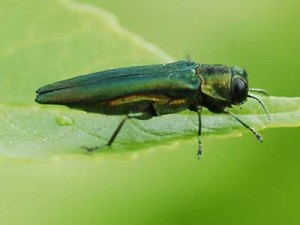
BOULDER, Colo. – Over the next six weeks, more than a thousand stingless, parasitic wasps that target emerald ash borer (EAB) – a destructive, non-native tree pest that poses a serious threat to Colorado’s urban forests – will be released in Boulder to help control the borer’s spread. This week, the interagency Colorado EAB Response Team,* of which the Colorado State Forest Service is a member, is coordinating the dispersal of the first 200 gnat-sized Oobius agrili, which target EAB eggs specifically, at known infested sites.
This is the second species of EAB parasitoid to be released in Colorado. In 2014, the team released the stingless wasp Tetrastichus planipennisi, which instead targets EAB larvae developing under the bark of ash trees.
The Colorado Department of Agriculture (CDA), University of Colorado and City of Boulder are working with the U.S. Department of Agriculture’s Animal and Plant Health Inspection Service (APHIS) to help suppress EAB populations in the city and manage the insect’s spread. The weekly Oobius releases this summer will occur on the University of Colorado campus, where last fall the team released the EAB larvae-killing parasitoids.
“We’re hoping that by releasing biocontrols like these, we can slow the spread and better manage the impacts of emerald ash borer in Colorado,” said John Kaltenbach, biological control specialist for the Colorado Department of Agriculture.
Oobius is the smallest of three parasitoid wasp species used as EAB biocontrols, and the only one that targets EAB eggs. When the wasp locates an EAB egg in tree bark crevices, it inserts its own egg inside the host egg, where it will hatch, grow and kill the EAB larva before it can emerge. The stingless wasps pose no threat to people or pets.
Kaltenbach says Oobius is effective at this time of year because EAB adults are now flying to lay eggs on new host trees. He says the EAB Response Team hopes private citizens also can be on the lookout for the half-inch-long, emerald-green beetles, as this is the best time of year to detect them visually.
USDA initiated a biological control effort shortly after EAB was detected in Michigan in 2002. In the borer’s native range of China, three potential biological control agents (stingless wasps) were identified – Oobius agrili, Tetrastichus planipennisi and Spathius agrili. After extensive evaluation – to determine the efficacy of the wasps at killing EAB and the possible impacts on native wood borers – they were first released in Michigan in 2007. Today the EAB Biological Control Production Facility rears the wasps for mass release; one or more wasp species have been released in 19 of the 25 states where EAB has been confirmed.
Later this summer, additional releases of Tetrastichus also are planned in Boulder.
EAB, a non-native pest responsible for the death of tens of millions of ash trees in the United States, was confirmed in the City of Boulder in September 2013. The exotic insect has become a concern for communities all over Colorado because each year it can fly up to a half-mile to infest new trees. There also is the ever-present risk of EAB spreading much faster through human transport of firewood and other raw wood. An estimated 15 percent or more of all urban and community trees in the state are ash (genus Fraxinus).
Learn More
More information about USDA’s Emerald Ash Borer Biocontrol Program can be found at http://www.aphis.usda.gov/publications/plant_health/2014/faq_eab_biocontrol.pdf.
For more information about ash tree identification, the symptoms of EAB and treatment options, as well as an updated map showing where EAB has been detected in Colorado, go to www.eabcolorado.com.
*The Colorado EAB Response Team is comprised of members from the following agencies/organizations: Boulder County, City of Boulder, Colorado Department of Agriculture, Colorado State Forest Service, Colorado State University Extension, Colorado Tree Coalition, Green Industries of Colorado, University of Colorado and USDA Animal and Plant Health Inspection Service.

